
Theodore Poulakis was a Greek Renaissance painter and teacher. He is considered the father of the Heptanese School and one of the most prolific painters of Venetian Crete. Poulakis was a member of the Cretan School, his contemporary was Emmanuel Tzanes. Emmanuel Tzanes and Poulakis were active painters of the Cretan School until Candia, went to war with the Ottomans around 1649. Candia finally fell after twenty years of siege in 1669. Poulakis settled on the island of Corfu. Stephanos Tzangarolas was another famous painter in Corfu around the same period. Poulakis's works are likened to Andreas Pavias and Georgios Klontzas. Poulakis works exhibit qualities of the Venetian school. Over 130 of his paintings have survived and can be found all over the world.

Andreas Ritzos also known as (Andreas Rico, Ricio or Rizo) was a Greek icon painter from Crete. Ritzos is considered one of the founding fathers of the Cretan School. He was affiliated with Angelos Akotantos. Most of his work stylistically follows the traditional maniera greca. His children, grandchildren, and great-grandchildren were also painters. He was one of the most influential painters of the Cretan School along with Andreas Pavias and Angelos Akotantos. He influenced the works of Georgios Klontzas, Nikolaos Tzafouris, Theophanes the Cretan, Michael Damaskinos and El Greco. According to the Institute for Neohellenic Research, sixty of his paintings have survived.

Nikolaos Tzafouris, also Niccolo, Niccolò, Niccolö, Zafuri, Zafuris, was a Greek Renaissance painter. He was one of the founders of the Cretan School. He was influenced by Angelos Akotantos. His works influenced Emmanuel Tzanes, Elias Moskos, Georgios Klontzas and Theodoros Poulakis. Tzafouris was one of the most respected artists in Crete. His most notable work is Madre della Consolazione. The painting exhibits a combination of Byzantine and Italian styles. Another notable painter in Crete around the same time was Andreas Pavias. According to the Institute of Neohellenic Research, thirteen paintings are attributed to Tzafouris.

Christ Bearing the Cross is a tempera painting attributed to Nikolaos Tzafouris. Nikolaos Tzafouris was a Greek painter. He is one of the founding members of the Cretan School along with Andreas Ritzos, Andreas Pavias, and Angelos Akotantos. He was influenced by Angelos Akotantos. According to the Institute of Neohellenic Research, thirteen paintings are attributed to Tzafouris. Tzafouris was active between 1480 and 1501. Tzafouris had a workshop in Heraklion. Tzafouris painted religious themes for local churches. The painting is a mixture of Italian and Greek Byzantine prototypes. The work followed the traditional maniera greca and was influenced by Venetian painting. His most notable works are the Madre della Consolazione and Christ Bearing the Cross. Christ Bearing the Cross is in Manhattan on display at Metropolitan Museum of Art.
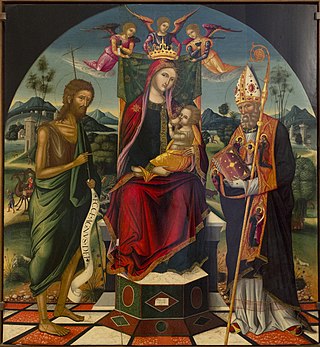
Ioannis Permeniates also known as Giovanni Permeniate, Joannes Permeniates and, Zuan Permeniatis. He was a Greek painter in Venice active during the early 16th century. His most popular painting is The Virgin and Child Enthroned. He was a Greek icon painter who attempted to escape the maniera greca. His icons exhibit qualities of both Venetian and Cretan styles. Exhibiting a more refined maniera greca, he eschews the simplicity of Duccio and Cimabue, and adds more space to his paintings.
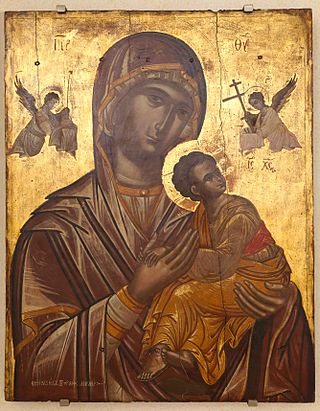
Emmanuel Tzanfournaris, also known as Emmanouil Manos was a Greek painter. He was a painter in Corfu and Venice. He was taught by famous painter Thomas Bathas. Emmanuel's father Georgios was also a famous painter. Emmanuel was active within the Greek Community of Venice until 1625. Some of his paintings are in the church of San Giorgio dei Greci. He was influenced by Michael Damaskinos and other Venetian painters. Tzanfournaris adopted the Venetian school but also stayed loyal to the maniera greca. He influenced the works of countless painters namely Emmanuel Tzanes, Franghias Kavertzas, Philotheos Skoufos and his son Theofilakto Tzanfournaris. Tzanfournaris artwork can be found all over the world. Sixteen of his paintings have survived.

Ιoannis Apakas, also known as Johann Apakass was a Greek painter and priest. He was active in the latter part of the 16th century to the early 17th century. He was popular artist during his time.
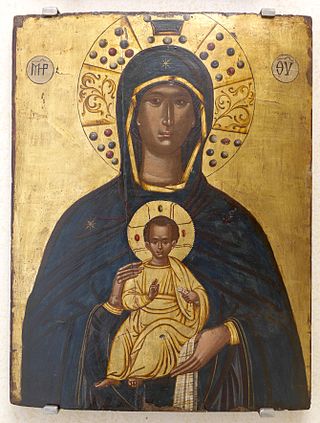
Thomas Bathas was a Greek painter, educator, and Vikar. He employed the maniera greca in some of his work but he also broke from tradition by employing the Venetian style. He traveled around the Venetian Empire going from Heraklion to Corfu and Venice. He was a prominent member of the Greek Confraternity in Venice. He was friends with Gabriel Severus, Metropolitan of Philadelphia. He was very popular among both Greek and Italian patrons. He influenced the works of countless artists both Italian and Greek. Some of his works are in San Giorgio dei Greci and the Hellenic Institute of Venice. Emmanuel Tzanes, Konstantinos Tzanes, Ioannis Moskos, and Philotheos Skoufos were some Greek artists influenced by his work. One of his students was the famous painter Emmanuel Tzanfournaris. He left him a fortune in his will. His most famous works include: Portrait of Gabriel Severus and Virgin and Child Enthroned. Twenty of his paintings have survived.
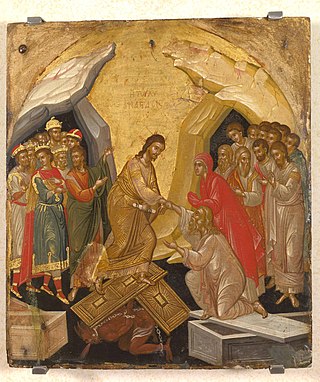
Markos Bathas was a painter, copper engraver, and writer. He was a prominent member of the Strelitzas-Bathas family. He may have been related to famous painters Theophanes Bathas and Thomas Bathas. Markos moved to Venice. He was the first Greek painter associated with San Giorgio dei Greci. Greek painter Michael Damaskinos was also in Venice during the 1560s. He follows the traditional maniera greca. He became a prominent member of the Greek community in Venice. Not much of his works survived. His icons can be found in Ioannina. He was an illustrator, he wrote some of the works of Plotinus. He created the works in an Italian-style text. He also created works with mythological themes.

Stephanos Tzangarolas also known as Stephano Tzangarola. He was a Greek painter during the late Cretan Renaissance. He migrated from Crete to the island of Corfu. He is a member of the Heptanese School and the Cretan Renaissance. His contemporaries at the time were Panagiotis Doxaras, Theodore Poulakis and Elias Moskos. His artwork began to reflect the transition of the classical maniera greca of Crete to the more refined style of the Ionian Islands. His style resembles the transition of Gentile da Fabriano and Fra Angelico from the maniera greca to their respective styles. Tzangarolas paintings influenced countless artists both Italian and Greek. Some artists that reflect his style include Spyridon Sperantzas and Georgios Kastrofylakas. His paintings can be found all over Greece mainly Athens and the Ionian Islands. Some of his work is in Cairo and London. His student was famous Greek painter Andreas Karantinos.
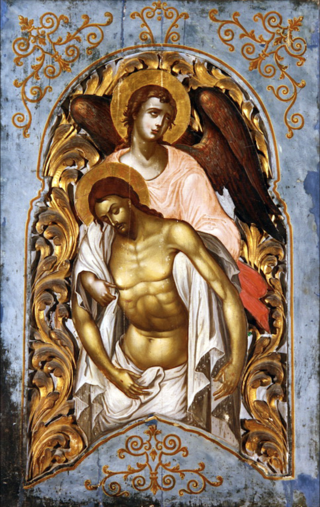
Nikolaos Kallergis, also known as Kalergis. He was a Greek painter during the Greek Rococo and the Modern Greek Enlightenment in art also known as Neo-Hellenikos Diafotismos. His art also exhibited Venetian influence. Painters of the maniera greca began to refine their art. Philotheos Skoufos, Elias Moskos, and Theodore Poulakis were all active painters on the Ionian Islands prior to Kallergis. They set the stage for the transition to the Heptanese School. Panagiotis Doxaras is the forefather of the new painting style. He was the father of Greek Rococo and the Modern Greek Enlightenment in painting. Kallergis became an active member of the school. Kallergis also represents the Greek Rococo. His art began to exhibit qualities of Greek and Italian Neoclassicism. His style influenced countless painters. Examples include Nikolaos Kantounis, Nikolaos Koutouzis, Nikolaos Doxaras, Spiridione Roma, and Eustathios Karousos. His most famous work is Christ and Angel it is at the Zakynthos Museum.

Antonios Papadopoulos was a Greek painter who represented the Cretan Renaissance. Papadopoulos, Andreas Pavias, Andreas Ritzos, and Nikolaos Tzafouris were all students of famous painter Angelos Akotantos. Papadopoulos reflects the sophistication and evolution of Byzantine painting to a more refined Venetian style. Although Cretan painting continued the tradition of the maniera greca, every icon reflected its own sophistication and uniqueness. Papadopoulos and his contemporaries influenced countless artists, namely Emmanuel Lambardos, Emmanuel Tzanfournaris, Thomas Bathas, and Markos Bathas. His most notable artwork is the Nursing Madonna or Galaktotrophousa. El Greco painted similar subject matter.

Nicholas Ritzos also known as Rizo and Ricio). He was a Greek Renaissance painter. His father was famous painter Andreas Ritzos. His brother was painter Thomas Ritzos. His son was painter Manea Ritzos. Nicholas and his father Andreas Ritzos are the forefathers of the Cretan School of painting. They influenced countless artists both Greek and Italian. There painting style was the typical Venetian influenced maniera greca in Crete. The island transitioned from the classical Byzantine painting to a more refined style. His contemporaries were Andreas Pavias, Nikolaos Tzafouris, and Angelos Akotantos. They influenced painters such as Michael Damaskinos, Petros Lambardos, and Emmanuel Lambardos. Nine of his works have survived.
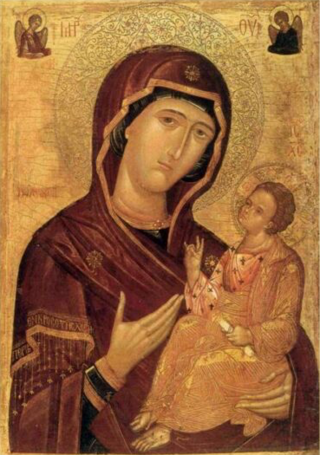
Nikolaos Lampoudis was a 15th Century Greek painter from Sparta. The only work of his of which historians are aware is an icon of the Virgin and Child of a kind known as a hodegetria or eleusa.

Georgios Markazinis, also known as Georgius Margazinis or Margazinius, was a Greek painter from the island of Crete. His style is different from his contemporaries. He can be likened to Ioannis Permeniates, Theodore Poulakis, Elias Moskos and Konstantinos Tzanes. His work escapes the typical lines of the maniera greca and his art is heavily influenced by the Venetian style. Only two of his works have survived. His most notable work is The Crucifixion. The Crucifixion is held at the Hellenic Institute in Venice. His other work is of the Last Judgment which is located in a church at Skradin, Croatia.

Madonna and Child enthroned with St. John the Baptist and St. Augustine is an oil painting by Greek painter Ioannis Permeniates. He was from Crete living in Venice. He was active during the first part of the 16th century. There are dozens of works attributed to the artist. He is a cross-over artist who painted in both the maniera greca and the Venetian style. Other similar artists were El Greco and Michael Damaskinos. Ioannis Permeniates's work was influenced by Vittore Carpaccio and Giovanni Bellini. His most notable painting is the Madonna and Child enthroned with St. John the Baptist and St. Augustine. Many Italian artists painted the same subject matter. The most famous painting depicting the subjects is the Madonna and Child with St John the Baptist and St Augustine by Petrus Perusinus. The Permeniates is part of the collection Museo Correr in Venice, Italy.
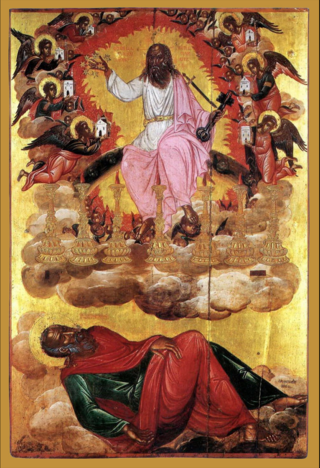
Vision of the ApocalypseApocalypse, also known as The Revelation of John the Evangelist, is a tempera painting by Thomas Bathas. The massive icon is over four hundred years old. Bathas was from the island of Crete. He was a painter active during the second half of the 16th century. He was active in Heraklion, Venice, and Corfu. He was an important member of the Cretan School. The painting follows the traditional maniera greca. The magnificent icon is on the Greek island of Patmos inside the Cave of the Apocalypse. The mysterious site is believed by Christians to mark the spot where John of Patmos received his visions that he recorded in the Book of Revelation.

The Virgin of the Passion is a famous rendition of the Madonna and Child by Greek painter Emmanuel Tzanfournaris. He was born in Corfu to the painter Georgios Tzanfournaris. By age twenty-nine Emmanuel moved to Venice. Emmanuel's teacher was painter Thomas Bathas. He met him on the island Corfu. Bathas left Emmanuel a sizable fortune in his will. Both painters created a famous version of the Virgin and Child. The Bathas version is called Virgin Nikopoios.

The Prophet Jonah was a tempera painting created by Demetrios Stavrakis. He was a Greek painter representing the Heptanese School. His nickname was Romanos. He was active during the 18th century. He flourished on the island of Zakynthos. He was the nephew of Stylianos Stavrakis and Andreas Stavrakis. Both were famous painters. He thrived during the Greek Rococo and Neoclassical eras in Greek art. Fifteen of his works survived.

The Nativity is an egg tempera painting by Victor. Victor is sometimes referred to as Victor of Crete. Victor was active from 1645 to 1696. He traveled all over the Venetian empire. He settled in Zakinthos. Some of his important works can be found in the church San Giorgio dei Greci in Venice. He is a very important Greek painter because of his existing catalog. His works of art exceed ninety-five paintings. One of his notable works was his version of Christ the Vine.


















